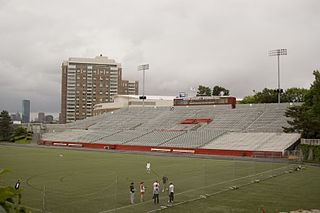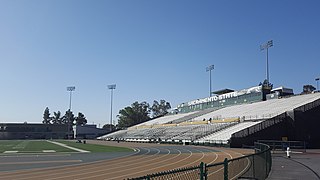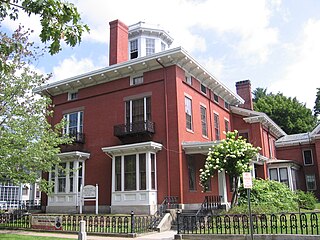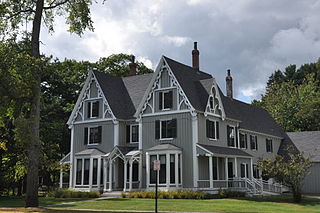
Bowdoin College is a private liberal arts college in Brunswick, Maine. At the time Bowdoin was chartered, in 1794, Maine was still a part of the Commonwealth of Massachusetts. The college offers 34 majors and 36 minors, as well as several joint engineering programs with Columbia, Caltech, Dartmouth College, and the University of Maine.

Brunswick is a town in Cumberland County, Maine, United States. The population was 20,278 at the 2010 United States Census. Part of the Portland-South Portland-Biddeford metropolitan area, Brunswick is home to Bowdoin College, the Bowdoin International Music Festival, the Bowdoin College Museum of Art, the Peary-MacMillan Arctic Museum, and the Maine State Music Theatre. It was formerly home to the U.S. Naval Air Station Brunswick, which was permanently closed on May 31, 2011, and has since been partially released to redevelopment as "Brunswick Landing".

Nickerson Field is an outdoor athletic stadium in the Northeastern United States, on the campus of Boston University (BU) in Boston, Massachusetts. The stadium is owned by BU, and is the home field for some Boston University Terriers athletics programs, including soccer and lacrosse. It was also the home of the Boston University Terriers football team until the program was discontinued following the 1997 season.
The Colby-Bates-Bowdoin Consortium (CBB) is an athletic conference and academic consortium between three private liberal arts colleges in the U.S. State of Maine. The group consists of Colby College in Waterville, Bates College in Lewiston, and Bowdoin College in Brunswick. In allusion to the Big Three of the Ivy League, Colby, Bates, and Bowdoin, are collectively known the "Maine Big Three", a play on words with the words "Maine" and "main". The school names are ordered by their geographical organization in Maine.

Harvard Stadium is a U-shaped college football stadium in the northeast United States, located in the Allston neighborhood of Boston, Massachusetts. The stadium is owned and operated by Harvard University and is home to the Harvard Crimson football program. The stadium's seating capacity is 30,323.

Fred Anderson Field is a 21,195-seat college football and track stadium in the western United States, on the campus of California State University, Sacramento in Sacramento, California. it is the home field of the Sacramento State Hornets of the Big Sky Conference.

Tad Gormley Stadium is a 26,500 seat multi-purpose outdoor stadium, located in City Park, in New Orleans, Louisiana.

Marquette Stadium was an outdoor athletic stadium in Milwaukee, Wisconsin, the home field of the Golden Avalanche of Marquette University, its intercollegiate football team. Located in the Merrill Park neighborhood west of the university, the stadium opened in 1924 and had a seating capacity of 24,000 at its peak. Citing financial issues, the football program was discontinued by the university in December 1960. The concrete grandstands were demolished in the summer of 1976.
Franklin Delano Roosevelt High School is a public high school located in Hyde Park, New York in Dutchess County. Named for President Franklin D. Roosevelt, who grew up in Hyde Park, the school serves about 1,300 students in grades 9 to 12 in the Hyde Park Central School District.

Massachusetts Hall is the oldest building on the campus of Bowdoin College, in Brunswick, Maine. It was built 1798–1802, and has seen a number of uses during the school's long history. The building was listed on the National Register of Historic Places in 1971.

The Skolfield–Whittier House is a Victorian museum of the Pejepscot Historical Society, located at 161 Park Row in Brunswick, Maine. It is often referred to as a "time capsule" because it has been virtually untouched since the Victorian era.

Brunswick Maine Street Station, or Brunswick Station, is a multi-modal, multi-use real estate development in Brunswick, Maine. Located on Maine Street, it consists of commercial offices, service centers, healthcare, retail, restaurants, theater and residential space. Brunswick Station is also a transportation hub for city buses, taxis, and passenger trains.
John Joseph Magee was an American track and field coach. He was head coach at Bowdoin College from 1913 to 1955 and assistant coach of the United States Olympic track and field team in 1924, 1928 and 1932.

The First Parish Church is a historic church at 207 Maine Street in Brunswick, Maine. Built in 1845 to a design by Richard Upjohn, it is a unique example of Gothic Revival architecture done in wood, as the church was built with vertical board-and-batten paneling. It was listed on the National Register of Historic Places in 1969. The congregation dates to 1717, and is affiliated with the United Church of Christ; the pastor is Rev. Mary Baard.

James Howard Horne was an athletic director and coach of American football, basketball, baseball, and track and field at Indiana University between 1898 and 1905.
The Bowdoin Polar Bears are the athletic teams that represent Bowdoin College in Brunswick, Maine. The polar bear team name was selected to honor Robert Peary of the class of 1877 who discovered the North Pole. The college fields thirty teams and compete in NCAA Division III; they are members of the New England Small College Athletic Conference.

The Henry Boody House also known as the Boody-Johnson House, is an historic house at 256 Maine Street in Brunswick, Maine, United States. Built in 1849, it is an important early example of Gothic Revival Architecture, whose design was published by Andrew Jackson Downing in 1850 and received wide notice. It was listed on the National Register of Historic Places on 1975.

The Colby Mules are the varsity and club athletic teams of Colby College, a liberal arts college located in Waterville, Maine. Colby's varsity teams compete in the New England Small College Athletic Conference of the National Collegiate Athletic Association (NCAA) Division III. The College offers 32 varsity teams, plus club sports, intramural sports called I-play.

The Bates Bobcats are the athletic teams of Bates College largely based in Lewiston, Maine and the surrounding areas. The college's official mascot has been the bobcat since 1924, and maintains garnet as its official color. The school sponsors 32 varsity sports, most of which compete in the Division III New England Small College Athletic Conference (NESCAC). The school's men's and women's ski teams and men's and women's squash teams compete in Division I. Bates has rivalries with Princeton in Squash and Dartmouth in Skiing and selected hockey bouts. The college also competes with its Maine rivals Bowdoin and Colby in the Colby-Bates-Bowdoin Consortium (CBB). This is one of the oldest football rivalries in the United States. This consortium is a series of historically highly competitive football games ending in the championship game between the three schools. Bates has won this championship at total of twelve times including 2014, 2015, and in 2016 beat Bowdoin 24–7 after their 21–19 abroad victory over Colby. Bates is currently the holder of the winning streak, and has the record for biggest victory in the athletic conference with a 51-0 shutout of Colby College. The three colleges also contest the Colby-Bates-Bowdoin Chase Regatta. The college is the all-time leader of the Chase Regatta with a total of 14 composite wins, followed by Colby's 5 wins, concluded with Bowdoin's 2 wins.
Niles Lee Perkins, Jr. was an American athlete and physician. Perkins was United States champion in men's 35-lb weight throw in 1940 and held the weight throw indoor world record for nine years. He was also a good hammer thrower and football player.
















